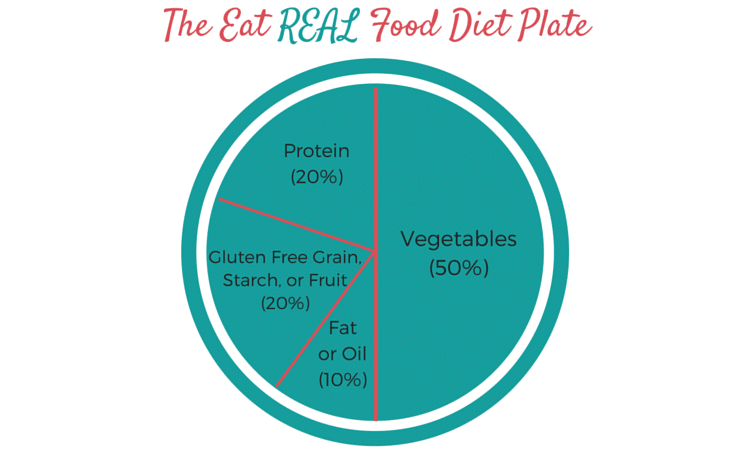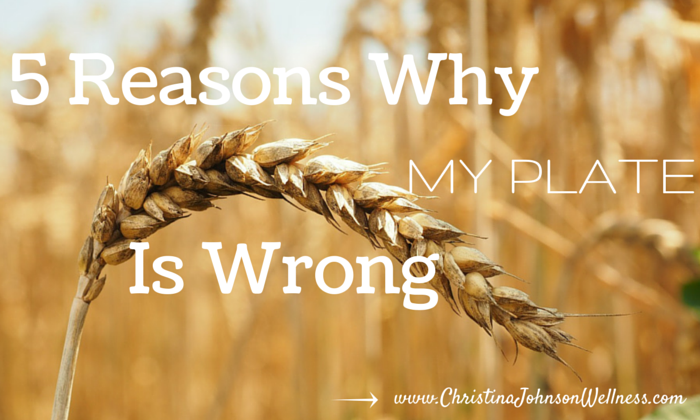I’m going to share a fact about myself that just might be controversial to some, but here it goes anyway…I intentionally do not follow (or agree with) the USDA’s My Plate recommendations.
Some of you may have a few guesses as to why this is the case, but others of you may be wondering why a health coach would not support the government’s recommendations on what constitutes a healthy diet…and that’s a great question!
To sum it up, my reasoning is based on the fact that the My Plate recommendations are not based on solid, scientific evidence, and they do not promote optimal health for our bodies.
More specifically, I have 5 reasons why I believe the My Plate recommendations are wrong.
5 Reasons Why My Plate is Wrong
1) Gimme more veggies!
Eating vegetables is one of the simplest and most effective ways to improve our overall health. All of the nutrients in vegetables help to maintain our internal systems (such as the digestive and excretory system), they provide the necessary nutrients for our organs to function properly, and they help us to maintain a healthy weight.
Therefore, vegetables should comprise about 50% of our diet. My theory…you really can’t get too many vegetables into your diet!
Another concern I have with the My Plate vegetables recommendation is that it includes starchy vegetables, beans, and peas within the vegetable category. Because these foods have different effects on our bodies and do not provide the same nutrients as other vegetables, they should be included in a separate category.
2) Whoa…watch the fruit.
Ok, I know that fruits, like vegetables, have many amazing nutrients and antioxidant properties. As a result, they can be part of a well-rounded, healthy diet.
HOWEVER, they also contain significant amounts of fructose. Even when fructose comes from a healthy source (such as fruit), it can still cause problems if consumed in excess. Excess amounts of fructose can lead to several health complications, including diabetes and excess belly fat [1].
Many individuals, especially women who are trying to lose weight, are sensitive to sugar and may be insulin resistant. Therefore, even though fruit does have many amazing health benefits, most people are wise to limit their intake of fruit to about 2 servings per day.
Also, contrary to the My Plate recommendations, fruit should preferably be eaten in it’s whole form, instead of being dried or in juice. Juice and dried fruit are much more likely to spike our blood sugar levels because they are a more concentrated source of sugar.
3) Where’s the fat?
Did you notice that fat is not even pictured on My Plate? As you may know from my article describing why our bodies actually need fat, this omission neglects a huge aspect of a healthy diet.
To make matters worse, if you dig around on their website (www.choosemyplate.gov), you will actually find the following statement:
To lower risk for heart disease, cut back on foods containing saturated fats, trans fats, and cholesterol [2].
While research does support the claim that trans fat causes devastating health complications, the same is not true for either saturated fat or cholesterol.
In fact, Dr. John Briffa describes 2 major studies that both conclude that saturated fat does not cause heart disease [3]. Dr. Mercola also describes several reasons why our bodies need saturated fat, such as for improved cardiovascular risk factors, improved liver health, a healthy brain, and a strong immune system [4].
If we follow My Plate’s recommendations, we are not providing our bodies with a nutrient which is critical to our overall health.
4) Not all grains are created equal.
Grains…such a tricky topic, even in the “eat real food” world. (Because of this, I will be writing an upcoming post dedicated to the topic of grains and gluten, so I’ll keep this section brief for now.)
My first concern is the fact that gluten containing grains are problematic for many people, whether they realize it or not. These grains can be the cause of a wide variety of symptoms, such as joint pain, bloating, fatigue, canker sores, infertility, thyroid disease, and so much more [5].
Many people experience relief from a variety of symptoms once they remove all sources of gluten from their diet.
In addition, even gluten-free grains are still not the best source of nutrients. You will find many more essential nutrients in vegetables, fruit, and meat. Some people may also experience digestive issues like inflammation, gas, bloating, constipation, and an irritation of the digestive system from grains of any kind [6].
Based on these facts, my recommendations regarding grains are as follows:
- Only consume gluten-free grains.
- If you choose to eat gluten-free grains (such as quinoa, rice, buckwheat, and oats), take time to make sure that they are not causing you any digestive distress.
- Consume gluten-free grains in moderation, up to one serving per day.
5) Dairy recommendations…are they really necessary?
Several problems exist with the dairy recommendations.
First, My Plate strongly encourages the consumption of low-fat or fat-free dairy products. As I have previously explained here, our bodies require fat to function. Also, when fat is removed from a product, that food is taken further away from it’s natural state, which makes it more difficult for our bodies to know what to do with it. Also, when fat is removed, other additives (like sugar) tend to be added in to make the product taste better.
Secondly, not everyone is able to digest dairy products properly. In nature, the enzyme lactase is actually found in raw milk. This enzyme helps our bodies digest milk. Unfortunately, the process of pasteurization destroys lactase, making it more difficult for people to digest pasteurized dairy products. This explains why some people who don’t digest pasteurized milk very well can actually do well with raw dairy.
Finally, so many other foods contain high amounts of calcium (such as sesame seeds, leafy greens, sardines, and almonds [7]) that consuming milk is simply not necessary to get calcium.
So What SHOULD You Eat?
A healthy diet always starts with eating REAL foods that have been minimally processed and are in as close to their natural state as possible. (Download the Eat Real Foods graphic to learn exactly which foods to eat and which foods to avoid.)
I am not a proponent of imposing a strict, complicated set of guidelines for people to follow. However, I understand that many people need to have an idea of where to begin.
So I have created the Eat REAL Food Diet Plate as an alternative to My Plate. The percentages on it are approximate and are not something to get hung up on. They should merely point you in the right direction so that you have an idea of where to start.

Below are the principles that describe the foundation of the Eat REAL Food Diet Plate:
Begin each meal by filling up approximately half of your plate with vegetables. Throughout the course of the day, include a variety of types and colors of vegetables. Be sure to include some leafy greens! Examples of some vegetables to include (although this list is definitely not exhaustive) are:
- Green leafy vegetables such as lettuce, kale, swiss chard, collard greens, and spinach
- A variety of colorful vegetables such as peppers, carrots, eggplant, asparagus, celery, cucumbers, onions, and garlic
- Cruciferous vegetables such as broccoli, cauliflower, brussels sprouts, and cabbage
Fill approximately 20% of your plate with a high quality protein such as grass fed beef or lamb, pasture raised chickens, eggs, organ meat, etc.
Fill up to 20% of your plate with gluten-free grains (but only if you tolerate them well) such as quinoa, buckwheat, or rice; a starchy vegetable such as sweet potatoes, squash, or plantains; or a serving of fruit.
Be sure to include 1-2 servings of fat with your meal. This may be butter, ghee, coconut oil, olive oil, avocado, nuts, seeds, etc.
Lastly, I want to emphasize again that I am not a fan of promoting a one-size-fits-all approach. These proportions are approximate and provide an excellent starting point. However, you may need to adjust them if you are not meeting your health and weight loss goals.
For example, if you participate in intensive workouts on a regular basis, you may want to slightly increase your carbohydrate content. For others with blood sugar regulation issues, you may want to more closely monitor all sources of sugar that you consume.
Some people experience digestive distress or have autoimmune conditions which improve with the elimination of certain foods such as grains, eggs, nightshades, or nuts.
All of these modifications can be made once you have a laid a solid foundation by eating REAL food.
Give It A Try!
My challenge to you this week is to create at least one meal based upon the recommendations of the Eat REAL Food Diet Plate. When you are finished eating, take note of how you are feeling. Do you feel full? Are you satisfied? Make some adjustments, and then try again!
Leave a comment below if you plan to give it a try!
Sources
[1] Barnes, Zahra. (2015, June 26). Are You Eating Too Much Fruit? [Blog post]. Retrieved from http://www.huffingtonpost.com/life-by-dailyburn-/are-you-eating-too-much-fruit_b_7640514.html
[2] http://www.choosemyplate.gov/food-groups/oils-how.html
[3] Briffa, John. (2010, January 15). Two Major Studies Conclude that Saturated Fat Does Not Cause Heart Disease [Blog post]. Retrieved from http://www.drbriffa.com/2010/01/15/two-major-studies-conclude-that-saturated-fat-does-not-cause-heart-disease/
[4] Mercola, Eric. (2009, September 22). 7 Reasons to Eat More Saturated Fat. Retrieved from http://articles.mercola.com/sites/articles/archive/2009/09/22/7-Reasons-to-Eat-More-Saturated-Fat.aspx
[5] Sanfilippo, Diane. (2010, July 23). Is Your Gut Leaky? [Blog post]. Retrieved from http://balancedbites.com/2010/07/is-your-gut-leaky.html
[6] Myers, Wendy. (n.d.) What Grains Are Safe To Eat? [Blog post]. Retrieved from https://liveto110.com/what-grains-are-safe-to-eat/
[7] Kresser, Chris. (2014, November 18). How to Keep Your Bones Healthy On a Paleo Diet [Blog post]. Retrieved from http://chriskresser.com/how-to-keep-your-bones-healthy-on-a-paleo-diet/



